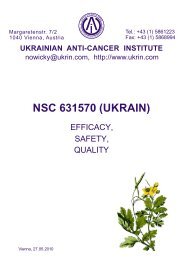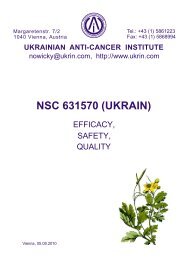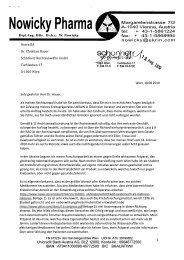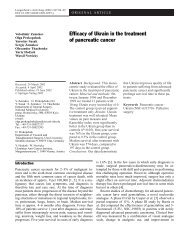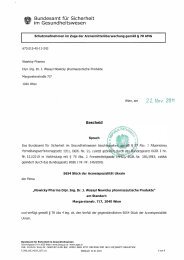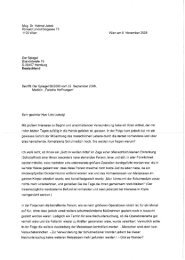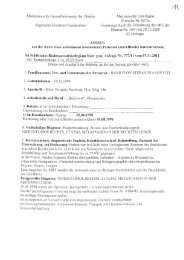Criminal Story of a Prevention - Ukrainian Anti Cancer Institute
Criminal Story of a Prevention - Ukrainian Anti Cancer Institute
Criminal Story of a Prevention - Ukrainian Anti Cancer Institute
You also want an ePaper? Increase the reach of your titles
YUMPU automatically turns print PDFs into web optimized ePapers that Google loves.
Harassment from All Sides<br />
The year 1993 brought international cancer research trail-blazing new evidence about<br />
the cancer process. In studies <strong>of</strong> cell death and ‘programmed cell death’ within cells,<br />
American and Australian scientists gained a completely new insight into understanding this<br />
insidious disease. According to them, cells have an inner clock which tells them when they<br />
must die. In cancer this clock does not seem to work, whereby the life <strong>of</strong> the cells is<br />
prolonged and the life <strong>of</strong> the carrier <strong>of</strong> these cells is put at risk. The cancer runs its course. It<br />
had already been known for a long time that in the development <strong>of</strong> embryos certain cells are<br />
programmed to die at a certain time. The researchers now discovered that this phenomenon<br />
was not confined to the development <strong>of</strong> embryos. In medical terminology this programmed<br />
cell death (PCD) is called apoptosis, a Greek expression for leaves falling from a tree or a<br />
plant.<br />
In 1993 these new findings were published in the renowned American journal<br />
‘Science’. At the time, cancer researchers throughout the world tried to find a substance<br />
which would force cancer cells to carry out the ‘suicide’ order. The first to find one was<br />
Pr<strong>of</strong>essor Liepins at the Memorial University in St. John’s, Canada. At the 11 th<br />
Interdisciplinary World Congress in Geneva he reported on his experiments with Ukrain as an<br />
agent <strong>of</strong> cell death at a session dedicated to Ukrain with a total <strong>of</strong> nine papers delivered. He<br />
had demonstrated in laboratory experiments that the alkaloid derivative from greater<br />
celandine, Ukrain, caused characteristic programmed cell death.<br />
With the exception <strong>of</strong> Nowicky, not a single Austrian was represented at the congress<br />
as a speaker. Austrian cancer specialists stayed away from this session. The fact that they<br />
continued to ignore this drug, which had been developed in Austria, can be explained in no<br />
other way.<br />
For years. Ukrain had been discussed at all international cancer congresses (far more<br />
than 100). Nowicky had been expressly invited to most <strong>of</strong> them including the 20 th<br />
International Congress <strong>of</strong> Chemotherapy from 29 June to 3 July 1997 in Sydney, Australia,<br />
where eleven speakers presented their results with Ukrain at a special session. Nowicky<br />
reported on a clinical study carried out in Poland in which Ukrain had been used to cause cell<br />
death in patients suffering from breast cancer. Even at the low dose <strong>of</strong> only 50 mg, Ukrain<br />
caused cell death in cancer cells. The number <strong>of</strong> cells which reacted was dependent on the<br />
malignancy <strong>of</strong> the cancer.<br />
In 1993 the connection was made between cancer and programmed cell death. In April<br />
1994 in Geneva, Ukrain was reported to be the trigger to bring about the death <strong>of</strong> cells which<br />
had refused to die. In June 1993 the Austrian Ministry <strong>of</strong> Health had given approval for<br />
clinical studies on the basis <strong>of</strong> a report from the drugs commission. In June 1994 the same<br />
ministry wrote to the regional health insurance authorities in Upper Austria (‘Re: Use <strong>of</strong><br />
Ukrain’) referring to a ‘general ban on the use <strong>of</strong> Ukrain due to a decree <strong>of</strong> the federal<br />
ministry <strong>of</strong> 25 July 1986 - although this ban had not been binding for a long time on purely<br />
formal grounds (there was no confirmation).<br />
It went on, ‘Until now, no definitive, state-<strong>of</strong>-the-art evidence <strong>of</strong> efficacy has been<br />
brought forward for the substance Ukrain.’ Furthermore, it was also pointed out that the list <strong>of</strong><br />
publications given to the health insurance authorities included publications which had also<br />
been given to the drugs commission for assessment. Why this fact should be detrimental was<br />
not explained. ‘Therefore,’ continued the letter with incestuous logic, ‘it is still not<br />
scientifically proven that the substance Ukrain can achieve the above-mentioned ‘success’.’ It<br />
also did not fail to refer to the fact that if Ukrain was administered outside the framework <strong>of</strong> a<br />
clinical study, a fine <strong>of</strong> ‘up to € 72,000’ was threatened.<br />
33



